A Literature Review of Green Practices in Multinational Companies
VerifiedAdded on 2023/05/29
|17
|5015
|199
Literature Review
AI Summary
This literature review explores the increasing emphasis on multinational corporations (MNCs) adopting green business operations in response to environmental challenges. It highlights the negative impacts of MNCs on emerging economies due to loose environmental policies and the potential for cost reduction and improved reputation through green initiatives. The review categorizes these efforts under Corporate Social Responsibility, focusing on workplace, community, environment, and marketplace dimensions. Stakeholder influence, including environmental awareness, government regulations, and shareholder pressure, drives firms to adopt green practices. Organizational characteristics like the distance between parent companies and subsidiaries, along with industrial and market pressures, also play a significant role. The methodology section outlines a quantitative research design using surveys to assess the influence of green policies and practices on green job behaviors, employing statistical techniques like correlation and regression for data analysis. The data collection procedure involves a structured questionnaire distributed among employees, with demographic details provided for the sample population.
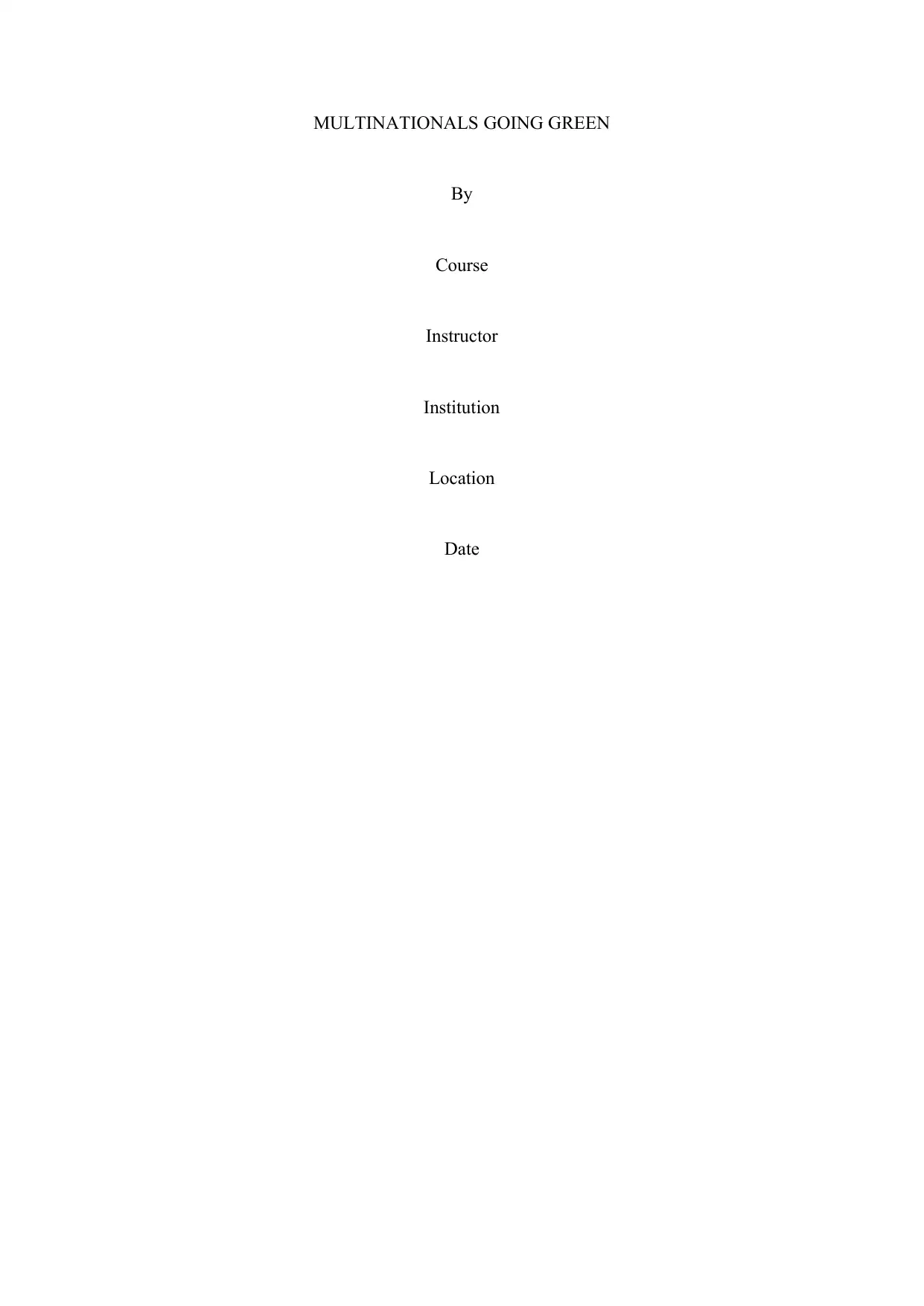
MULTINATIONALS GOING GREEN
By
Course
Instructor
Institution
Location
Date
By
Course
Instructor
Institution
Location
Date
Paraphrase This Document
Need a fresh take? Get an instant paraphrase of this document with our AI Paraphraser
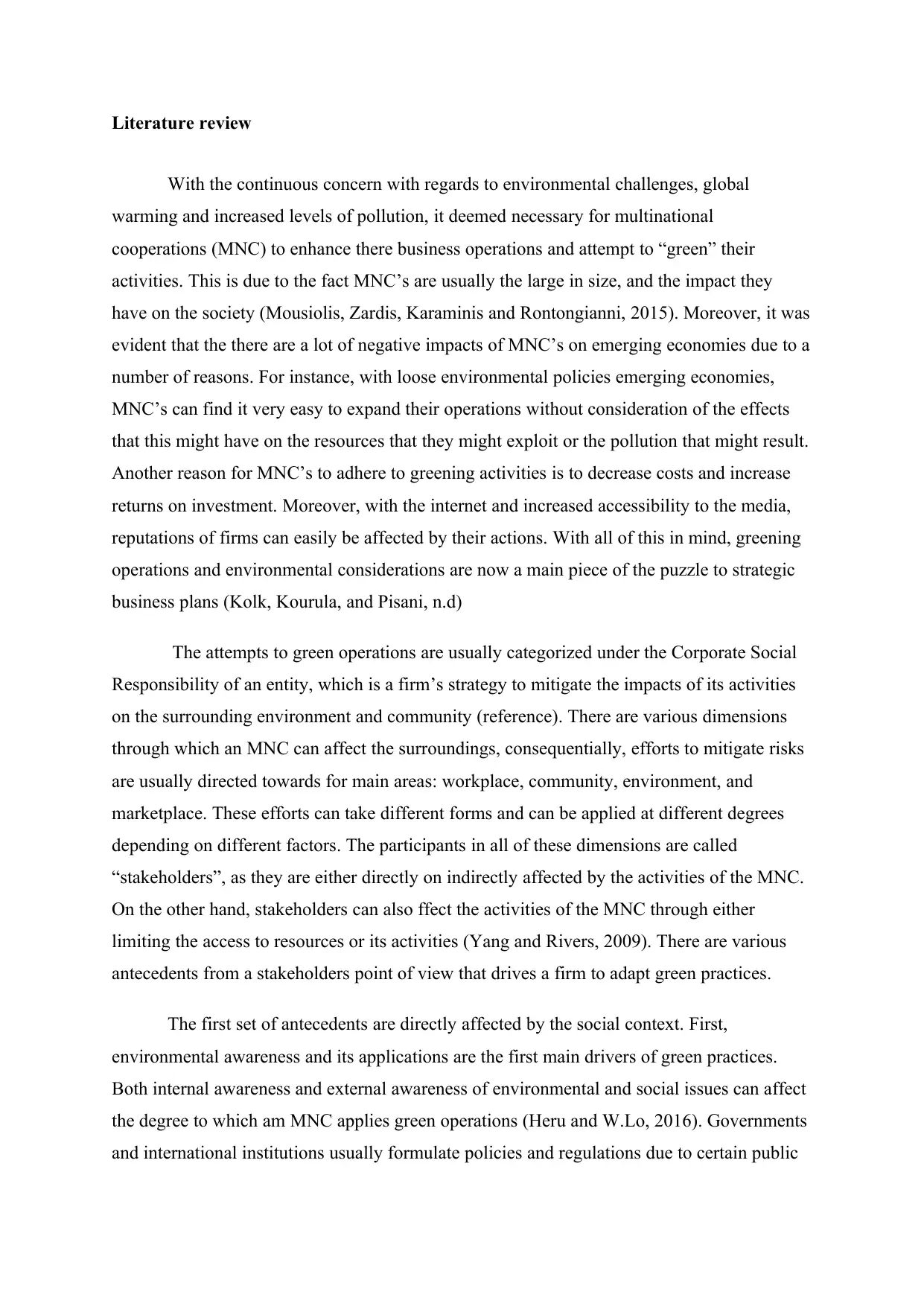
Literature review
With the continuous concern with regards to environmental challenges, global
warming and increased levels of pollution, it deemed necessary for multinational
cooperations (MNC) to enhance there business operations and attempt to “green” their
activities. This is due to the fact MNC’s are usually the large in size, and the impact they
have on the society (Mousiolis, Zardis, Karaminis and Rontongianni, 2015). Moreover, it was
evident that the there are a lot of negative impacts of MNC’s on emerging economies due to a
number of reasons. For instance, with loose environmental policies emerging economies,
MNC’s can find it very easy to expand their operations without consideration of the effects
that this might have on the resources that they might exploit or the pollution that might result.
Another reason for MNC’s to adhere to greening activities is to decrease costs and increase
returns on investment. Moreover, with the internet and increased accessibility to the media,
reputations of firms can easily be affected by their actions. With all of this in mind, greening
operations and environmental considerations are now a main piece of the puzzle to strategic
business plans (Kolk, Kourula, and Pisani, n.d)
The attempts to green operations are usually categorized under the Corporate Social
Responsibility of an entity, which is a firm’s strategy to mitigate the impacts of its activities
on the surrounding environment and community (reference). There are various dimensions
through which an MNC can affect the surroundings, consequentially, efforts to mitigate risks
are usually directed towards for main areas: workplace, community, environment, and
marketplace. These efforts can take different forms and can be applied at different degrees
depending on different factors. The participants in all of these dimensions are called
“stakeholders”, as they are either directly on indirectly affected by the activities of the MNC.
On the other hand, stakeholders can also ffect the activities of the MNC through either
limiting the access to resources or its activities (Yang and Rivers, 2009). There are various
antecedents from a stakeholders point of view that drives a firm to adapt green practices.
The first set of antecedents are directly affected by the social context. First,
environmental awareness and its applications are the first main drivers of green practices.
Both internal awareness and external awareness of environmental and social issues can affect
the degree to which am MNC applies green operations (Heru and W.Lo, 2016). Governments
and international institutions usually formulate policies and regulations due to certain public
With the continuous concern with regards to environmental challenges, global
warming and increased levels of pollution, it deemed necessary for multinational
cooperations (MNC) to enhance there business operations and attempt to “green” their
activities. This is due to the fact MNC’s are usually the large in size, and the impact they
have on the society (Mousiolis, Zardis, Karaminis and Rontongianni, 2015). Moreover, it was
evident that the there are a lot of negative impacts of MNC’s on emerging economies due to a
number of reasons. For instance, with loose environmental policies emerging economies,
MNC’s can find it very easy to expand their operations without consideration of the effects
that this might have on the resources that they might exploit or the pollution that might result.
Another reason for MNC’s to adhere to greening activities is to decrease costs and increase
returns on investment. Moreover, with the internet and increased accessibility to the media,
reputations of firms can easily be affected by their actions. With all of this in mind, greening
operations and environmental considerations are now a main piece of the puzzle to strategic
business plans (Kolk, Kourula, and Pisani, n.d)
The attempts to green operations are usually categorized under the Corporate Social
Responsibility of an entity, which is a firm’s strategy to mitigate the impacts of its activities
on the surrounding environment and community (reference). There are various dimensions
through which an MNC can affect the surroundings, consequentially, efforts to mitigate risks
are usually directed towards for main areas: workplace, community, environment, and
marketplace. These efforts can take different forms and can be applied at different degrees
depending on different factors. The participants in all of these dimensions are called
“stakeholders”, as they are either directly on indirectly affected by the activities of the MNC.
On the other hand, stakeholders can also ffect the activities of the MNC through either
limiting the access to resources or its activities (Yang and Rivers, 2009). There are various
antecedents from a stakeholders point of view that drives a firm to adapt green practices.
The first set of antecedents are directly affected by the social context. First,
environmental awareness and its applications are the first main drivers of green practices.
Both internal awareness and external awareness of environmental and social issues can affect
the degree to which am MNC applies green operations (Heru and W.Lo, 2016). Governments
and international institutions usually formulate policies and regulations due to certain public
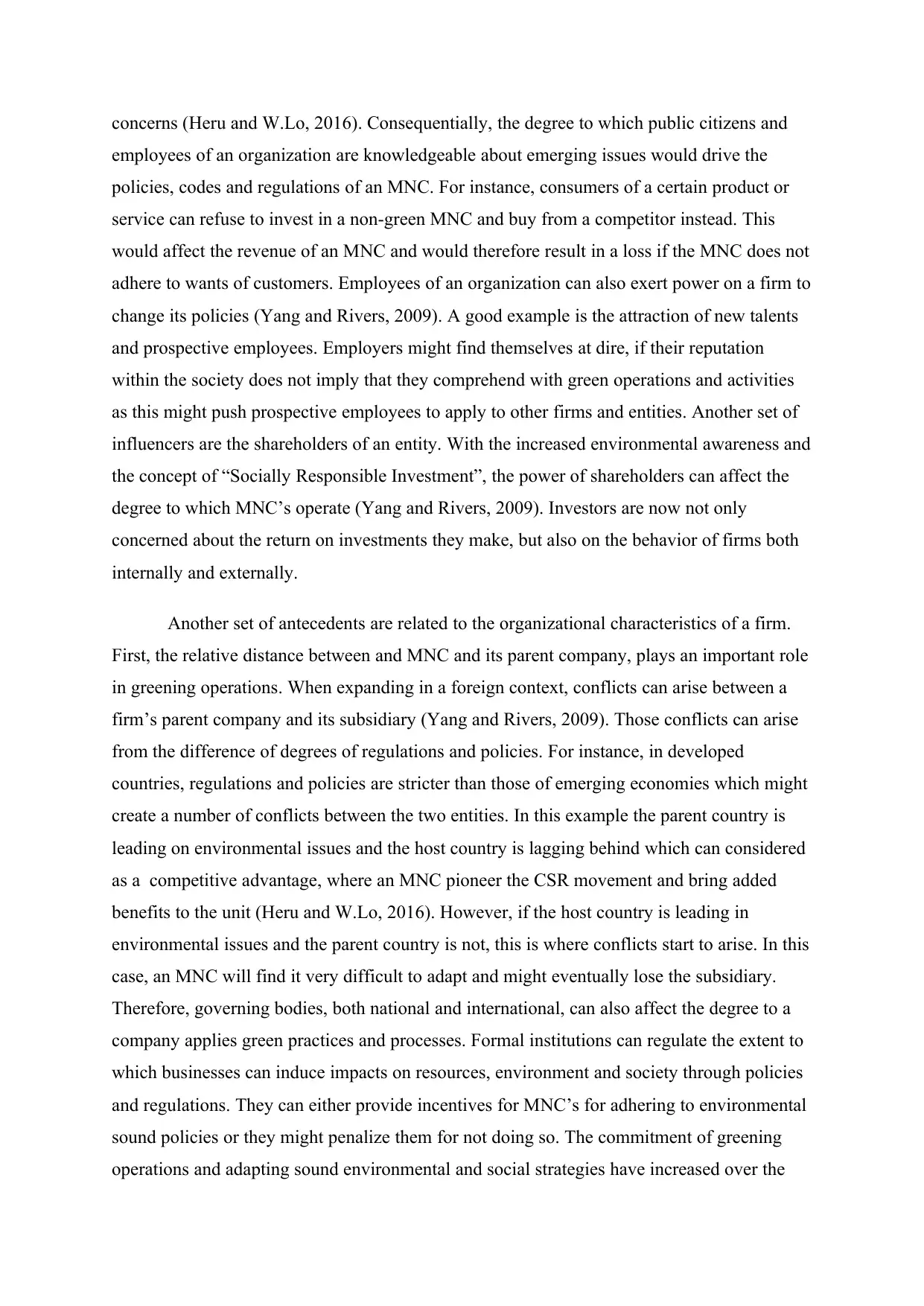
concerns (Heru and W.Lo, 2016). Consequentially, the degree to which public citizens and
employees of an organization are knowledgeable about emerging issues would drive the
policies, codes and regulations of an MNC. For instance, consumers of a certain product or
service can refuse to invest in a non-green MNC and buy from a competitor instead. This
would affect the revenue of an MNC and would therefore result in a loss if the MNC does not
adhere to wants of customers. Employees of an organization can also exert power on a firm to
change its policies (Yang and Rivers, 2009). A good example is the attraction of new talents
and prospective employees. Employers might find themselves at dire, if their reputation
within the society does not imply that they comprehend with green operations and activities
as this might push prospective employees to apply to other firms and entities. Another set of
influencers are the shareholders of an entity. With the increased environmental awareness and
the concept of “Socially Responsible Investment”, the power of shareholders can affect the
degree to which MNC’s operate (Yang and Rivers, 2009). Investors are now not only
concerned about the return on investments they make, but also on the behavior of firms both
internally and externally.
Another set of antecedents are related to the organizational characteristics of a firm.
First, the relative distance between and MNC and its parent company, plays an important role
in greening operations. When expanding in a foreign context, conflicts can arise between a
firm’s parent company and its subsidiary (Yang and Rivers, 2009). Those conflicts can arise
from the difference of degrees of regulations and policies. For instance, in developed
countries, regulations and policies are stricter than those of emerging economies which might
create a number of conflicts between the two entities. In this example the parent country is
leading on environmental issues and the host country is lagging behind which can considered
as a competitive advantage, where an MNC pioneer the CSR movement and bring added
benefits to the unit (Heru and W.Lo, 2016). However, if the host country is leading in
environmental issues and the parent country is not, this is where conflicts start to arise. In this
case, an MNC will find it very difficult to adapt and might eventually lose the subsidiary.
Therefore, governing bodies, both national and international, can also affect the degree to a
company applies green practices and processes. Formal institutions can regulate the extent to
which businesses can induce impacts on resources, environment and society through policies
and regulations. They can either provide incentives for MNC’s for adhering to environmental
sound policies or they might penalize them for not doing so. The commitment of greening
operations and adapting sound environmental and social strategies have increased over the
employees of an organization are knowledgeable about emerging issues would drive the
policies, codes and regulations of an MNC. For instance, consumers of a certain product or
service can refuse to invest in a non-green MNC and buy from a competitor instead. This
would affect the revenue of an MNC and would therefore result in a loss if the MNC does not
adhere to wants of customers. Employees of an organization can also exert power on a firm to
change its policies (Yang and Rivers, 2009). A good example is the attraction of new talents
and prospective employees. Employers might find themselves at dire, if their reputation
within the society does not imply that they comprehend with green operations and activities
as this might push prospective employees to apply to other firms and entities. Another set of
influencers are the shareholders of an entity. With the increased environmental awareness and
the concept of “Socially Responsible Investment”, the power of shareholders can affect the
degree to which MNC’s operate (Yang and Rivers, 2009). Investors are now not only
concerned about the return on investments they make, but also on the behavior of firms both
internally and externally.
Another set of antecedents are related to the organizational characteristics of a firm.
First, the relative distance between and MNC and its parent company, plays an important role
in greening operations. When expanding in a foreign context, conflicts can arise between a
firm’s parent company and its subsidiary (Yang and Rivers, 2009). Those conflicts can arise
from the difference of degrees of regulations and policies. For instance, in developed
countries, regulations and policies are stricter than those of emerging economies which might
create a number of conflicts between the two entities. In this example the parent country is
leading on environmental issues and the host country is lagging behind which can considered
as a competitive advantage, where an MNC pioneer the CSR movement and bring added
benefits to the unit (Heru and W.Lo, 2016). However, if the host country is leading in
environmental issues and the parent country is not, this is where conflicts start to arise. In this
case, an MNC will find it very difficult to adapt and might eventually lose the subsidiary.
Therefore, governing bodies, both national and international, can also affect the degree to a
company applies green practices and processes. Formal institutions can regulate the extent to
which businesses can induce impacts on resources, environment and society through policies
and regulations. They can either provide incentives for MNC’s for adhering to environmental
sound policies or they might penalize them for not doing so. The commitment of greening
operations and adapting sound environmental and social strategies have increased over the
⊘ This is a preview!⊘
Do you want full access?
Subscribe today to unlock all pages.

Trusted by 1+ million students worldwide
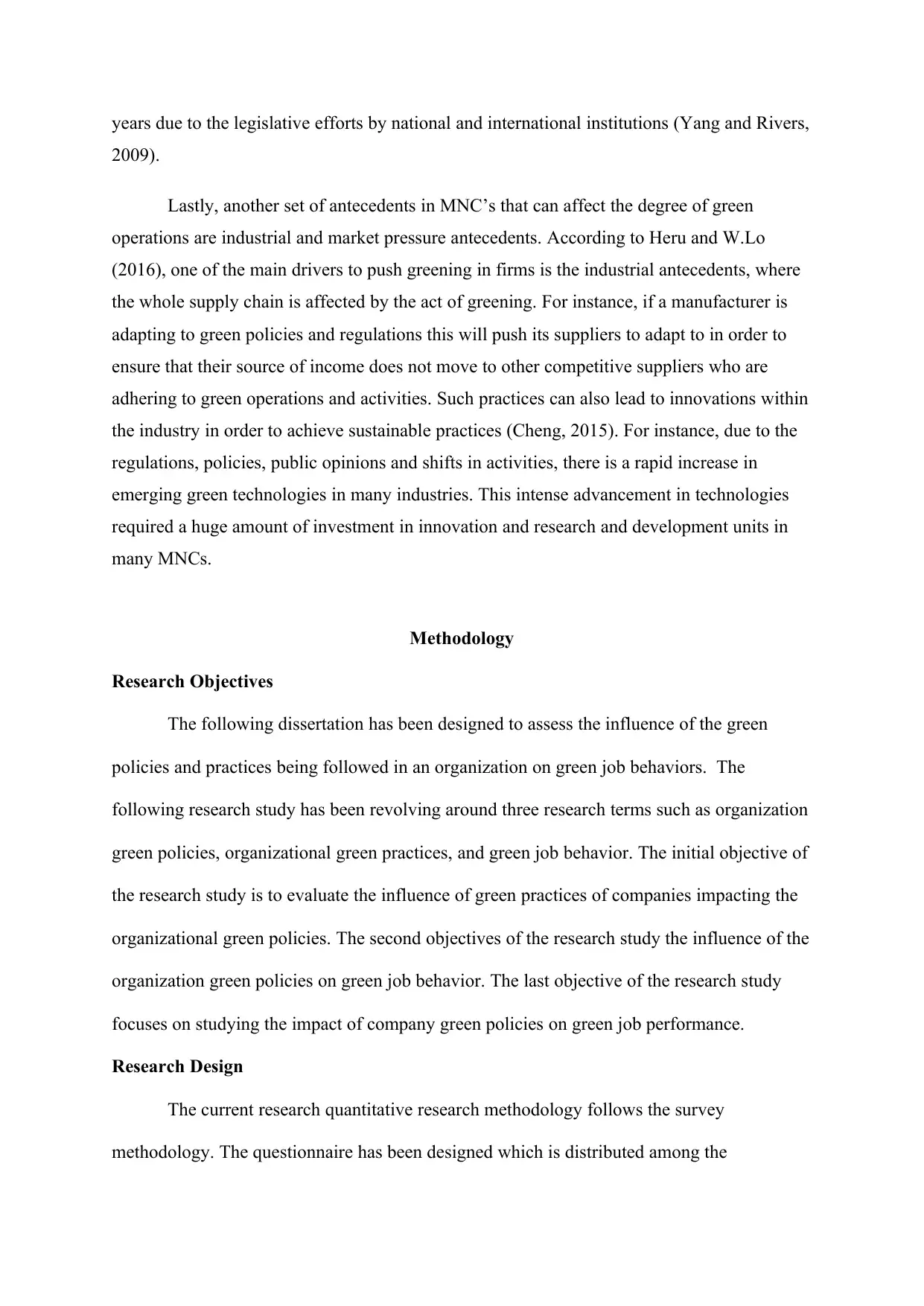
years due to the legislative efforts by national and international institutions (Yang and Rivers,
2009).
Lastly, another set of antecedents in MNC’s that can affect the degree of green
operations are industrial and market pressure antecedents. According to Heru and W.Lo
(2016), one of the main drivers to push greening in firms is the industrial antecedents, where
the whole supply chain is affected by the act of greening. For instance, if a manufacturer is
adapting to green policies and regulations this will push its suppliers to adapt to in order to
ensure that their source of income does not move to other competitive suppliers who are
adhering to green operations and activities. Such practices can also lead to innovations within
the industry in order to achieve sustainable practices (Cheng, 2015). For instance, due to the
regulations, policies, public opinions and shifts in activities, there is a rapid increase in
emerging green technologies in many industries. This intense advancement in technologies
required a huge amount of investment in innovation and research and development units in
many MNCs.
Methodology
Research Objectives
The following dissertation has been designed to assess the influence of the green
policies and practices being followed in an organization on green job behaviors. The
following research study has been revolving around three research terms such as organization
green policies, organizational green practices, and green job behavior. The initial objective of
the research study is to evaluate the influence of green practices of companies impacting the
organizational green policies. The second objectives of the research study the influence of the
organization green policies on green job behavior. The last objective of the research study
focuses on studying the impact of company green policies on green job performance.
Research Design
The current research quantitative research methodology follows the survey
methodology. The questionnaire has been designed which is distributed among the
2009).
Lastly, another set of antecedents in MNC’s that can affect the degree of green
operations are industrial and market pressure antecedents. According to Heru and W.Lo
(2016), one of the main drivers to push greening in firms is the industrial antecedents, where
the whole supply chain is affected by the act of greening. For instance, if a manufacturer is
adapting to green policies and regulations this will push its suppliers to adapt to in order to
ensure that their source of income does not move to other competitive suppliers who are
adhering to green operations and activities. Such practices can also lead to innovations within
the industry in order to achieve sustainable practices (Cheng, 2015). For instance, due to the
regulations, policies, public opinions and shifts in activities, there is a rapid increase in
emerging green technologies in many industries. This intense advancement in technologies
required a huge amount of investment in innovation and research and development units in
many MNCs.
Methodology
Research Objectives
The following dissertation has been designed to assess the influence of the green
policies and practices being followed in an organization on green job behaviors. The
following research study has been revolving around three research terms such as organization
green policies, organizational green practices, and green job behavior. The initial objective of
the research study is to evaluate the influence of green practices of companies impacting the
organizational green policies. The second objectives of the research study the influence of the
organization green policies on green job behavior. The last objective of the research study
focuses on studying the impact of company green policies on green job performance.
Research Design
The current research quantitative research methodology follows the survey
methodology. The questionnaire has been designed which is distributed among the
Paraphrase This Document
Need a fresh take? Get an instant paraphrase of this document with our AI Paraphraser
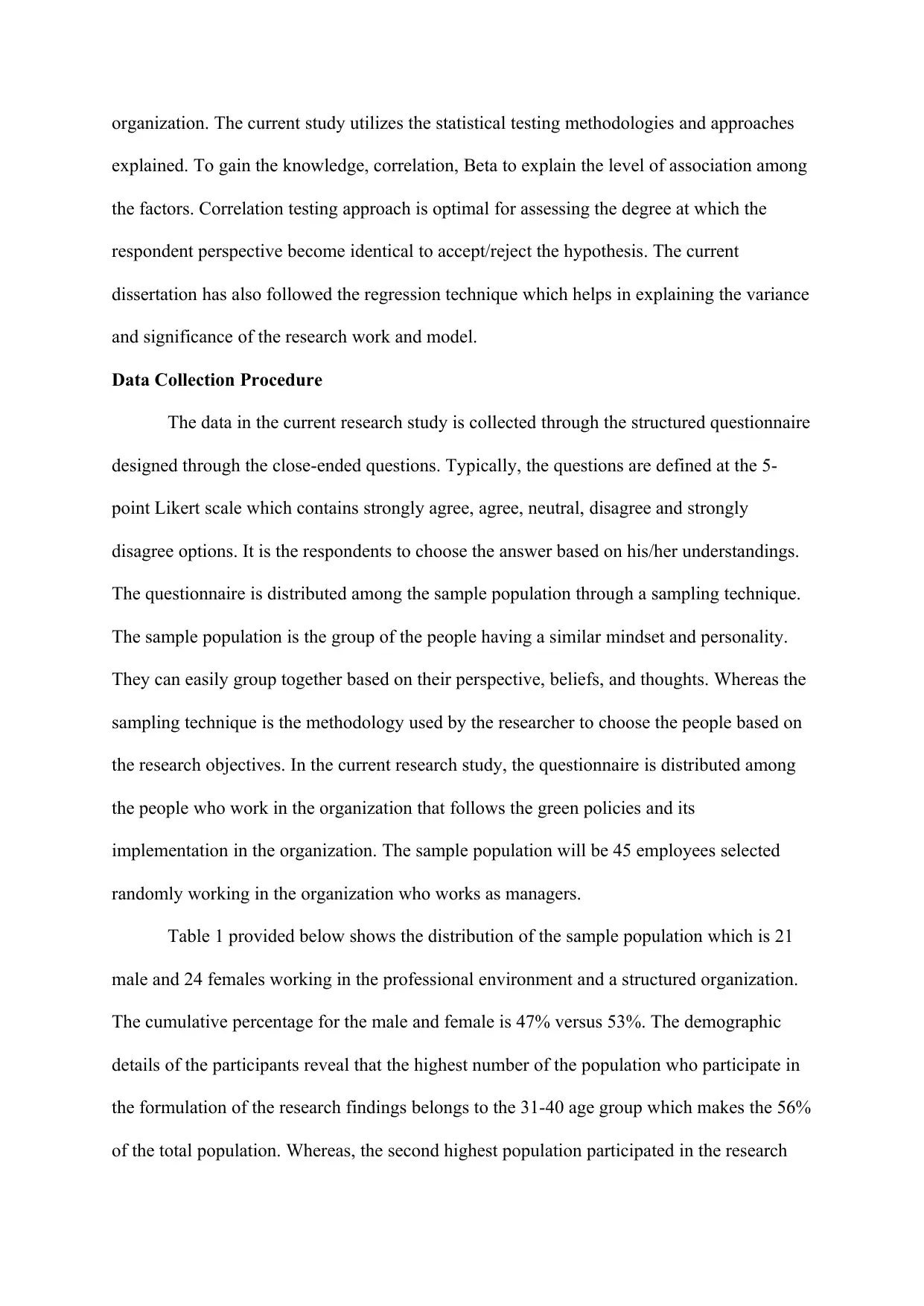
organization. The current study utilizes the statistical testing methodologies and approaches
explained. To gain the knowledge, correlation, Beta to explain the level of association among
the factors. Correlation testing approach is optimal for assessing the degree at which the
respondent perspective become identical to accept/reject the hypothesis. The current
dissertation has also followed the regression technique which helps in explaining the variance
and significance of the research work and model.
Data Collection Procedure
The data in the current research study is collected through the structured questionnaire
designed through the close-ended questions. Typically, the questions are defined at the 5-
point Likert scale which contains strongly agree, agree, neutral, disagree and strongly
disagree options. It is the respondents to choose the answer based on his/her understandings.
The questionnaire is distributed among the sample population through a sampling technique.
The sample population is the group of the people having a similar mindset and personality.
They can easily group together based on their perspective, beliefs, and thoughts. Whereas the
sampling technique is the methodology used by the researcher to choose the people based on
the research objectives. In the current research study, the questionnaire is distributed among
the people who work in the organization that follows the green policies and its
implementation in the organization. The sample population will be 45 employees selected
randomly working in the organization who works as managers.
Table 1 provided below shows the distribution of the sample population which is 21
male and 24 females working in the professional environment and a structured organization.
The cumulative percentage for the male and female is 47% versus 53%. The demographic
details of the participants reveal that the highest number of the population who participate in
the formulation of the research findings belongs to the 31-40 age group which makes the 56%
of the total population. Whereas, the second highest population participated in the research
explained. To gain the knowledge, correlation, Beta to explain the level of association among
the factors. Correlation testing approach is optimal for assessing the degree at which the
respondent perspective become identical to accept/reject the hypothesis. The current
dissertation has also followed the regression technique which helps in explaining the variance
and significance of the research work and model.
Data Collection Procedure
The data in the current research study is collected through the structured questionnaire
designed through the close-ended questions. Typically, the questions are defined at the 5-
point Likert scale which contains strongly agree, agree, neutral, disagree and strongly
disagree options. It is the respondents to choose the answer based on his/her understandings.
The questionnaire is distributed among the sample population through a sampling technique.
The sample population is the group of the people having a similar mindset and personality.
They can easily group together based on their perspective, beliefs, and thoughts. Whereas the
sampling technique is the methodology used by the researcher to choose the people based on
the research objectives. In the current research study, the questionnaire is distributed among
the people who work in the organization that follows the green policies and its
implementation in the organization. The sample population will be 45 employees selected
randomly working in the organization who works as managers.
Table 1 provided below shows the distribution of the sample population which is 21
male and 24 females working in the professional environment and a structured organization.
The cumulative percentage for the male and female is 47% versus 53%. The demographic
details of the participants reveal that the highest number of the population who participate in
the formulation of the research findings belongs to the 31-40 age group which makes the 56%
of the total population. Whereas, the second highest population participated in the research
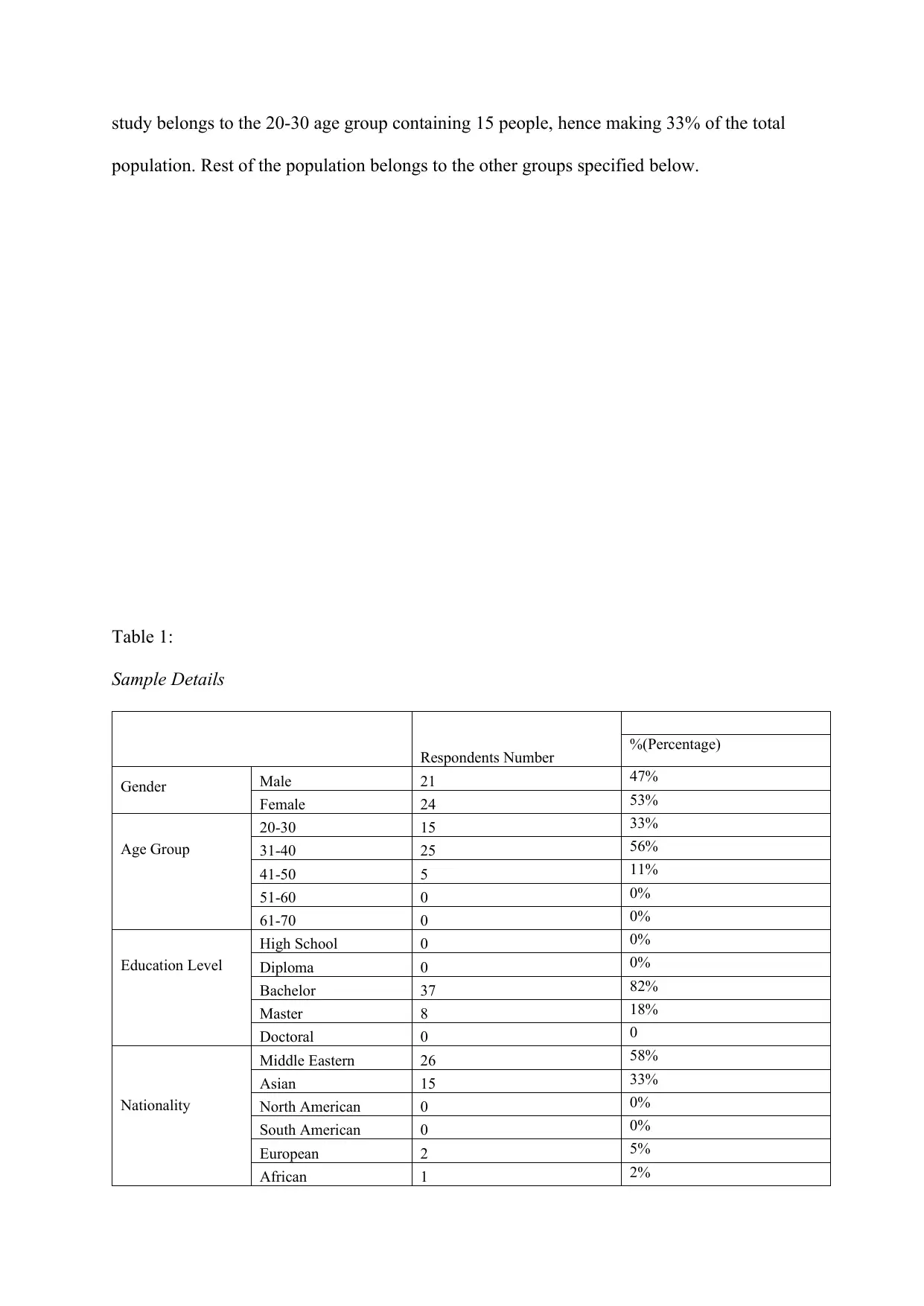
study belongs to the 20-30 age group containing 15 people, hence making 33% of the total
population. Rest of the population belongs to the other groups specified below.
Table 1:
Sample Details
Respondents Number %(Percentage)
Gender Male 21 47%
Female 24 53%
Age Group
20-30 15 33%
31-40 25 56%
41-50 5 11%
51-60 0 0%
61-70 0 0%
Education Level
High School 0 0%
Diploma 0 0%
Bachelor 37 82%
Master 8 18%
Doctoral 0 0
Nationality
Middle Eastern 26 58%
Asian 15 33%
North American 0 0%
South American 0 0%
European 2 5%
African 1 2%
population. Rest of the population belongs to the other groups specified below.
Table 1:
Sample Details
Respondents Number %(Percentage)
Gender Male 21 47%
Female 24 53%
Age Group
20-30 15 33%
31-40 25 56%
41-50 5 11%
51-60 0 0%
61-70 0 0%
Education Level
High School 0 0%
Diploma 0 0%
Bachelor 37 82%
Master 8 18%
Doctoral 0 0
Nationality
Middle Eastern 26 58%
Asian 15 33%
North American 0 0%
South American 0 0%
European 2 5%
African 1 2%
⊘ This is a preview!⊘
Do you want full access?
Subscribe today to unlock all pages.

Trusted by 1+ million students worldwide
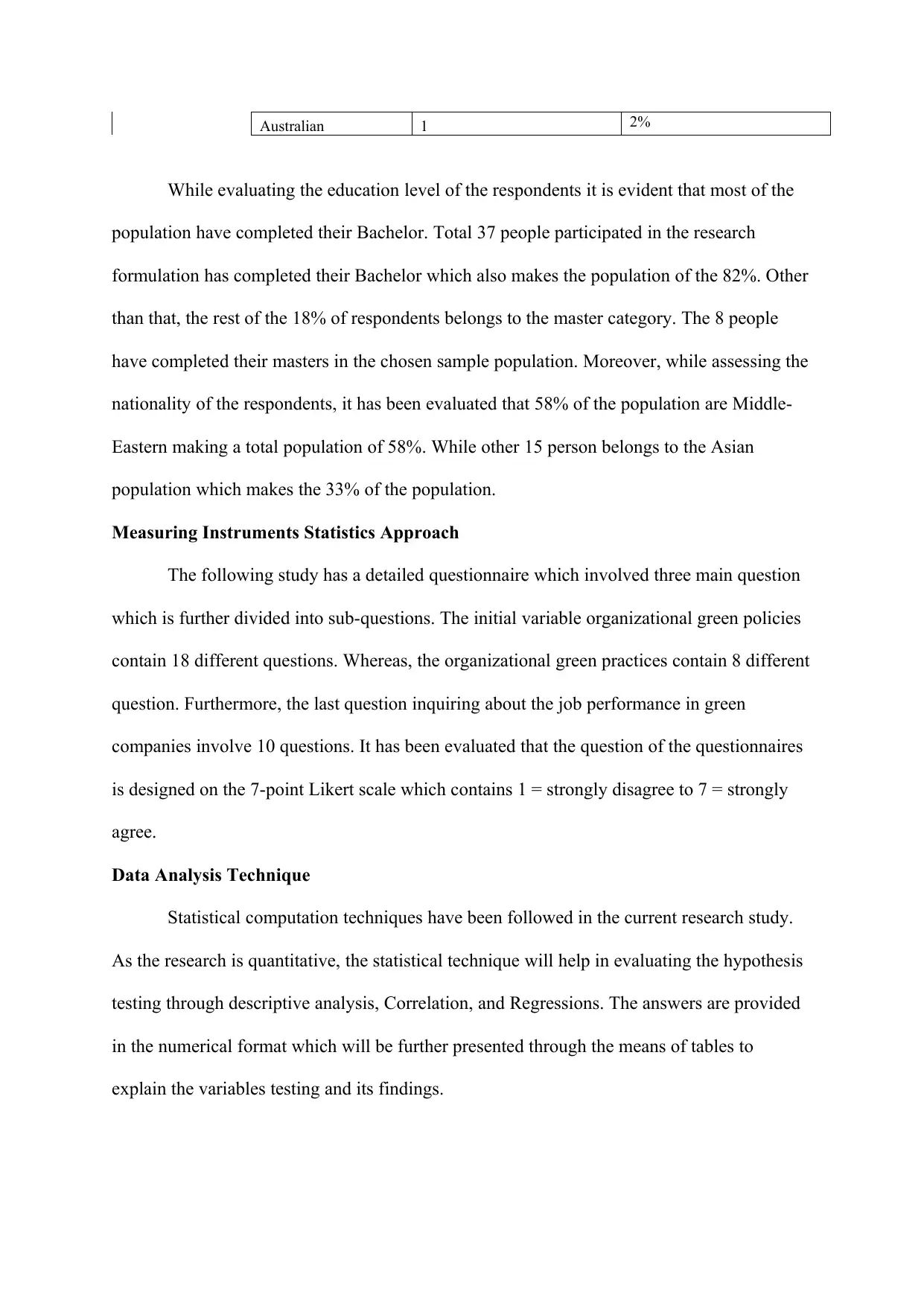
Australian 1 2%
While evaluating the education level of the respondents it is evident that most of the
population have completed their Bachelor. Total 37 people participated in the research
formulation has completed their Bachelor which also makes the population of the 82%. Other
than that, the rest of the 18% of respondents belongs to the master category. The 8 people
have completed their masters in the chosen sample population. Moreover, while assessing the
nationality of the respondents, it has been evaluated that 58% of the population are Middle-
Eastern making a total population of 58%. While other 15 person belongs to the Asian
population which makes the 33% of the population.
Measuring Instruments Statistics Approach
The following study has a detailed questionnaire which involved three main question
which is further divided into sub-questions. The initial variable organizational green policies
contain 18 different questions. Whereas, the organizational green practices contain 8 different
question. Furthermore, the last question inquiring about the job performance in green
companies involve 10 questions. It has been evaluated that the question of the questionnaires
is designed on the 7-point Likert scale which contains 1 = strongly disagree to 7 = strongly
agree.
Data Analysis Technique
Statistical computation techniques have been followed in the current research study.
As the research is quantitative, the statistical technique will help in evaluating the hypothesis
testing through descriptive analysis, Correlation, and Regressions. The answers are provided
in the numerical format which will be further presented through the means of tables to
explain the variables testing and its findings.
While evaluating the education level of the respondents it is evident that most of the
population have completed their Bachelor. Total 37 people participated in the research
formulation has completed their Bachelor which also makes the population of the 82%. Other
than that, the rest of the 18% of respondents belongs to the master category. The 8 people
have completed their masters in the chosen sample population. Moreover, while assessing the
nationality of the respondents, it has been evaluated that 58% of the population are Middle-
Eastern making a total population of 58%. While other 15 person belongs to the Asian
population which makes the 33% of the population.
Measuring Instruments Statistics Approach
The following study has a detailed questionnaire which involved three main question
which is further divided into sub-questions. The initial variable organizational green policies
contain 18 different questions. Whereas, the organizational green practices contain 8 different
question. Furthermore, the last question inquiring about the job performance in green
companies involve 10 questions. It has been evaluated that the question of the questionnaires
is designed on the 7-point Likert scale which contains 1 = strongly disagree to 7 = strongly
agree.
Data Analysis Technique
Statistical computation techniques have been followed in the current research study.
As the research is quantitative, the statistical technique will help in evaluating the hypothesis
testing through descriptive analysis, Correlation, and Regressions. The answers are provided
in the numerical format which will be further presented through the means of tables to
explain the variables testing and its findings.
Paraphrase This Document
Need a fresh take? Get an instant paraphrase of this document with our AI Paraphraser
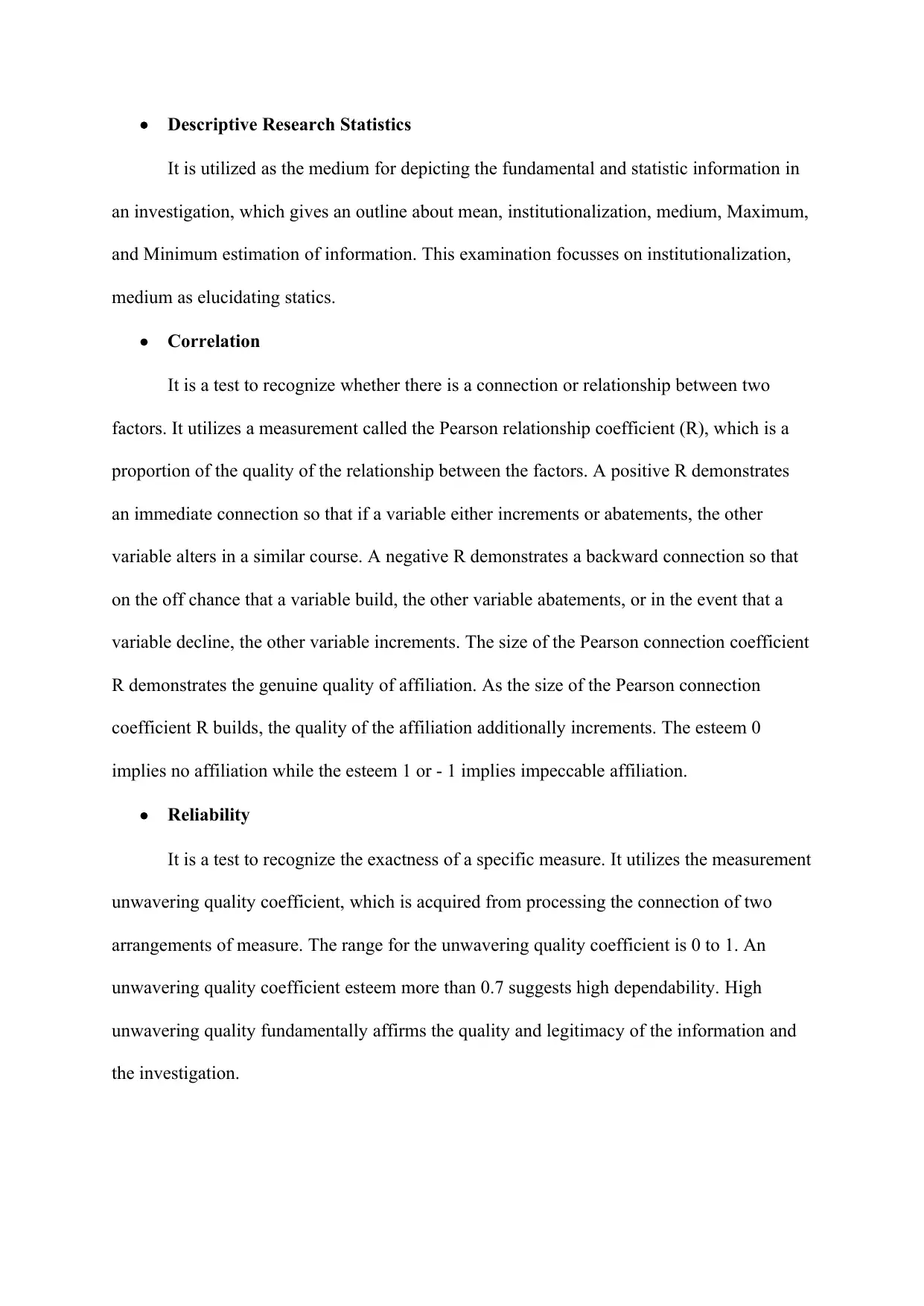
Descriptive Research Statistics
It is utilized as the medium for depicting the fundamental and statistic information in
an investigation, which gives an outline about mean, institutionalization, medium, Maximum,
and Minimum estimation of information. This examination focusses on institutionalization,
medium as elucidating statics.
Correlation
It is a test to recognize whether there is a connection or relationship between two
factors. It utilizes a measurement called the Pearson relationship coefficient (R), which is a
proportion of the quality of the relationship between the factors. A positive R demonstrates
an immediate connection so that if a variable either increments or abatements, the other
variable alters in a similar course. A negative R demonstrates a backward connection so that
on the off chance that a variable build, the other variable abatements, or in the event that a
variable decline, the other variable increments. The size of the Pearson connection coefficient
R demonstrates the genuine quality of affiliation. As the size of the Pearson connection
coefficient R builds, the quality of the affiliation additionally increments. The esteem 0
implies no affiliation while the esteem 1 or - 1 implies impeccable affiliation.
Reliability
It is a test to recognize the exactness of a specific measure. It utilizes the measurement
unwavering quality coefficient, which is acquired from processing the connection of two
arrangements of measure. The range for the unwavering quality coefficient is 0 to 1. An
unwavering quality coefficient esteem more than 0.7 suggests high dependability. High
unwavering quality fundamentally affirms the quality and legitimacy of the information and
the investigation.
It is utilized as the medium for depicting the fundamental and statistic information in
an investigation, which gives an outline about mean, institutionalization, medium, Maximum,
and Minimum estimation of information. This examination focusses on institutionalization,
medium as elucidating statics.
Correlation
It is a test to recognize whether there is a connection or relationship between two
factors. It utilizes a measurement called the Pearson relationship coefficient (R), which is a
proportion of the quality of the relationship between the factors. A positive R demonstrates
an immediate connection so that if a variable either increments or abatements, the other
variable alters in a similar course. A negative R demonstrates a backward connection so that
on the off chance that a variable build, the other variable abatements, or in the event that a
variable decline, the other variable increments. The size of the Pearson connection coefficient
R demonstrates the genuine quality of affiliation. As the size of the Pearson connection
coefficient R builds, the quality of the affiliation additionally increments. The esteem 0
implies no affiliation while the esteem 1 or - 1 implies impeccable affiliation.
Reliability
It is a test to recognize the exactness of a specific measure. It utilizes the measurement
unwavering quality coefficient, which is acquired from processing the connection of two
arrangements of measure. The range for the unwavering quality coefficient is 0 to 1. An
unwavering quality coefficient esteem more than 0.7 suggests high dependability. High
unwavering quality fundamentally affirms the quality and legitimacy of the information and
the investigation.
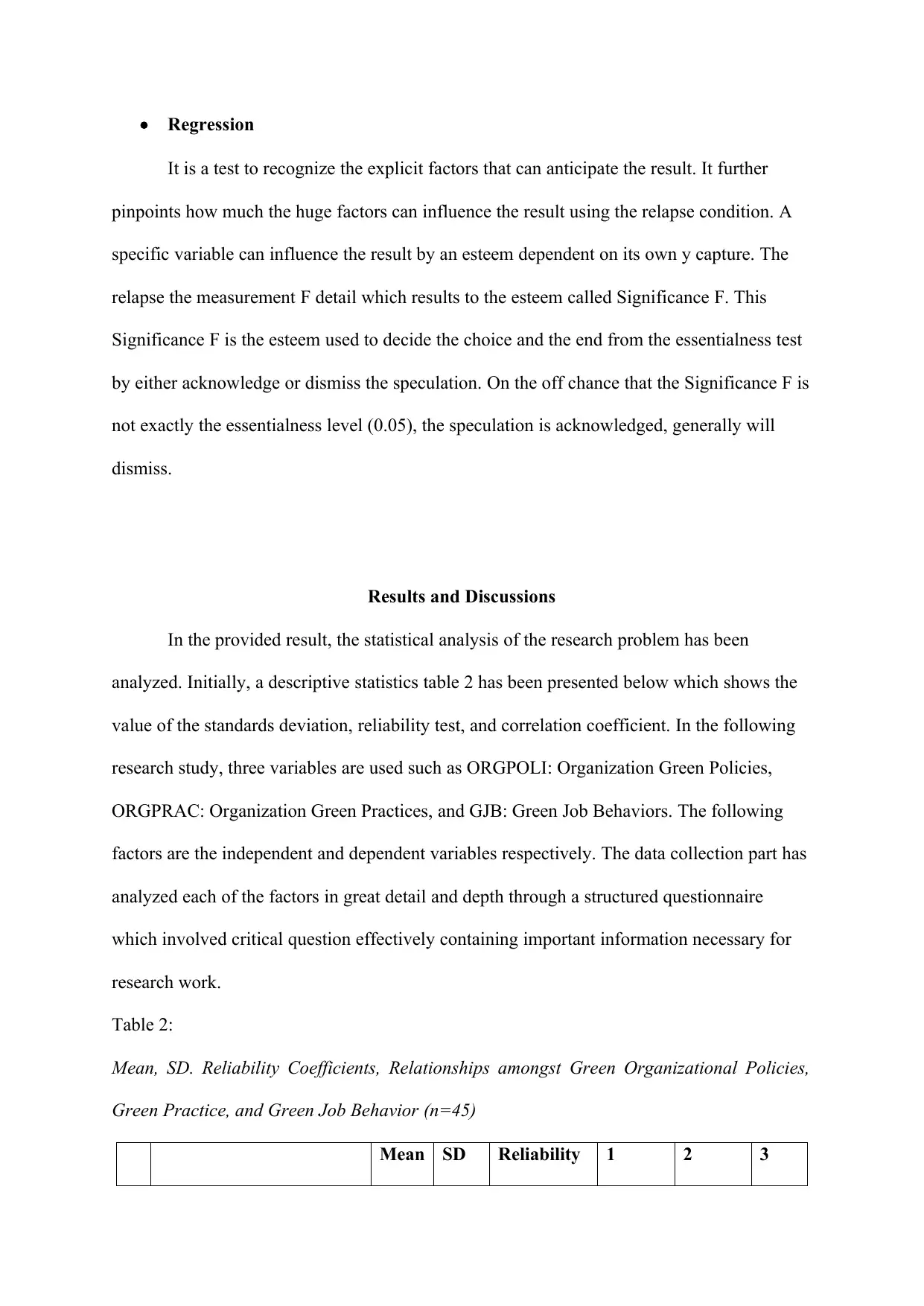
Regression
It is a test to recognize the explicit factors that can anticipate the result. It further
pinpoints how much the huge factors can influence the result using the relapse condition. A
specific variable can influence the result by an esteem dependent on its own y capture. The
relapse the measurement F detail which results to the esteem called Significance F. This
Significance F is the esteem used to decide the choice and the end from the essentialness test
by either acknowledge or dismiss the speculation. On the off chance that the Significance F is
not exactly the essentialness level (0.05), the speculation is acknowledged, generally will
dismiss.
Results and Discussions
In the provided result, the statistical analysis of the research problem has been
analyzed. Initially, a descriptive statistics table 2 has been presented below which shows the
value of the standards deviation, reliability test, and correlation coefficient. In the following
research study, three variables are used such as ORGPOLI: Organization Green Policies,
ORGPRAC: Organization Green Practices, and GJB: Green Job Behaviors. The following
factors are the independent and dependent variables respectively. The data collection part has
analyzed each of the factors in great detail and depth through a structured questionnaire
which involved critical question effectively containing important information necessary for
research work.
Table 2:
Mean, SD. Reliability Coefficients, Relationships amongst Green Organizational Policies,
Green Practice, and Green Job Behavior (n=45)
Mean SD Reliability 1 2 3
It is a test to recognize the explicit factors that can anticipate the result. It further
pinpoints how much the huge factors can influence the result using the relapse condition. A
specific variable can influence the result by an esteem dependent on its own y capture. The
relapse the measurement F detail which results to the esteem called Significance F. This
Significance F is the esteem used to decide the choice and the end from the essentialness test
by either acknowledge or dismiss the speculation. On the off chance that the Significance F is
not exactly the essentialness level (0.05), the speculation is acknowledged, generally will
dismiss.
Results and Discussions
In the provided result, the statistical analysis of the research problem has been
analyzed. Initially, a descriptive statistics table 2 has been presented below which shows the
value of the standards deviation, reliability test, and correlation coefficient. In the following
research study, three variables are used such as ORGPOLI: Organization Green Policies,
ORGPRAC: Organization Green Practices, and GJB: Green Job Behaviors. The following
factors are the independent and dependent variables respectively. The data collection part has
analyzed each of the factors in great detail and depth through a structured questionnaire
which involved critical question effectively containing important information necessary for
research work.
Table 2:
Mean, SD. Reliability Coefficients, Relationships amongst Green Organizational Policies,
Green Practice, and Green Job Behavior (n=45)
Mean SD Reliability 1 2 3
⊘ This is a preview!⊘
Do you want full access?
Subscribe today to unlock all pages.

Trusted by 1+ million students worldwide
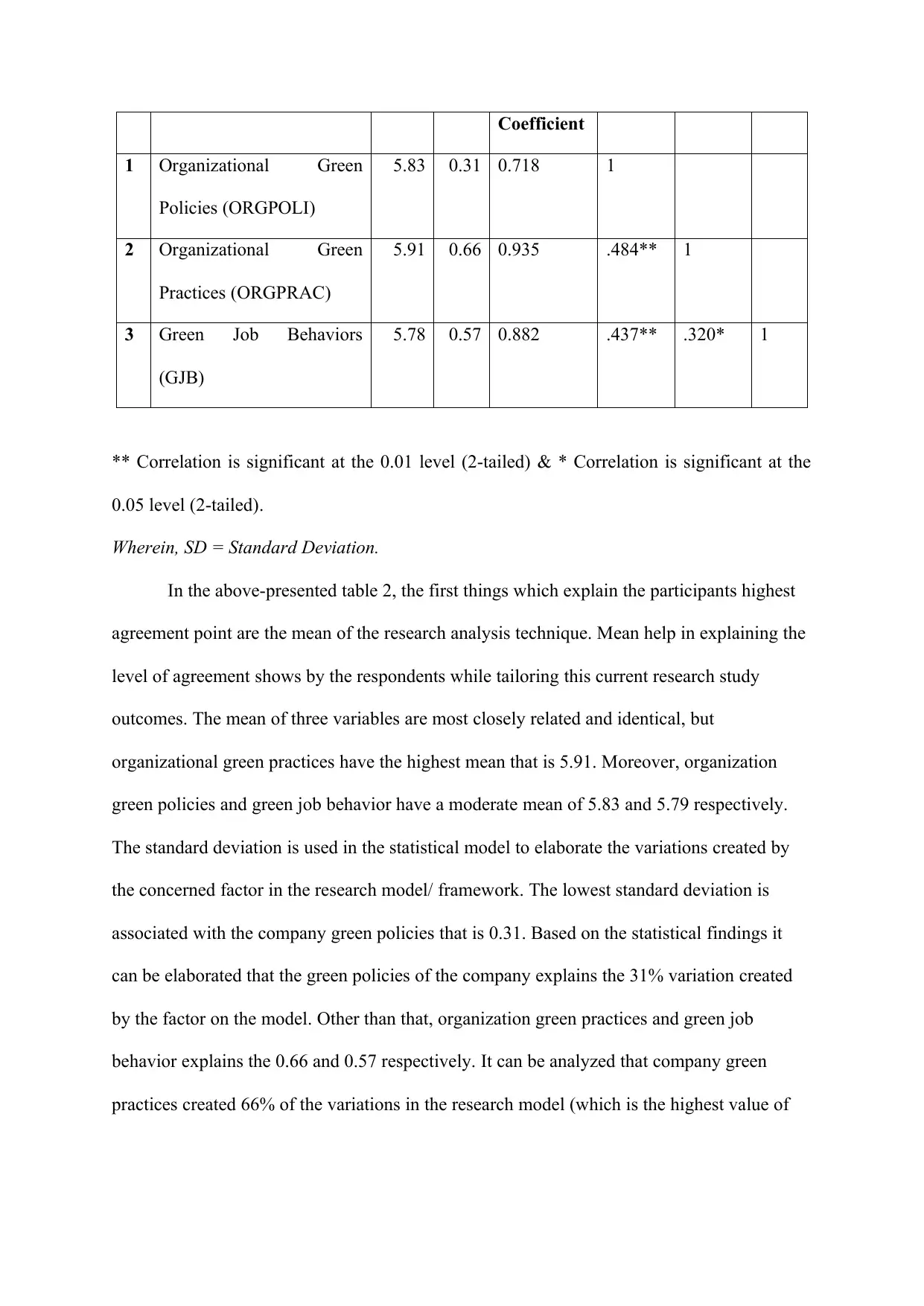
Coefficient
1 Organizational Green
Policies (ORGPOLI)
5.83 0.31 0.718 1
2 Organizational Green
Practices (ORGPRAC)
5.91 0.66 0.935 .484** 1
3 Green Job Behaviors
(GJB)
5.78 0.57 0.882 .437** .320* 1
** Correlation is significant at the 0.01 level (2-tailed) & * Correlation is significant at the
0.05 level (2-tailed).
Wherein, SD = Standard Deviation.
In the above-presented table 2, the first things which explain the participants highest
agreement point are the mean of the research analysis technique. Mean help in explaining the
level of agreement shows by the respondents while tailoring this current research study
outcomes. The mean of three variables are most closely related and identical, but
organizational green practices have the highest mean that is 5.91. Moreover, organization
green policies and green job behavior have a moderate mean of 5.83 and 5.79 respectively.
The standard deviation is used in the statistical model to elaborate the variations created by
the concerned factor in the research model/ framework. The lowest standard deviation is
associated with the company green policies that is 0.31. Based on the statistical findings it
can be elaborated that the green policies of the company explains the 31% variation created
by the factor on the model. Other than that, organization green practices and green job
behavior explains the 0.66 and 0.57 respectively. It can be analyzed that company green
practices created 66% of the variations in the research model (which is the highest value of
1 Organizational Green
Policies (ORGPOLI)
5.83 0.31 0.718 1
2 Organizational Green
Practices (ORGPRAC)
5.91 0.66 0.935 .484** 1
3 Green Job Behaviors
(GJB)
5.78 0.57 0.882 .437** .320* 1
** Correlation is significant at the 0.01 level (2-tailed) & * Correlation is significant at the
0.05 level (2-tailed).
Wherein, SD = Standard Deviation.
In the above-presented table 2, the first things which explain the participants highest
agreement point are the mean of the research analysis technique. Mean help in explaining the
level of agreement shows by the respondents while tailoring this current research study
outcomes. The mean of three variables are most closely related and identical, but
organizational green practices have the highest mean that is 5.91. Moreover, organization
green policies and green job behavior have a moderate mean of 5.83 and 5.79 respectively.
The standard deviation is used in the statistical model to elaborate the variations created by
the concerned factor in the research model/ framework. The lowest standard deviation is
associated with the company green policies that is 0.31. Based on the statistical findings it
can be elaborated that the green policies of the company explains the 31% variation created
by the factor on the model. Other than that, organization green practices and green job
behavior explains the 0.66 and 0.57 respectively. It can be analyzed that company green
practices created 66% of the variations in the research model (which is the highest value of
Paraphrase This Document
Need a fresh take? Get an instant paraphrase of this document with our AI Paraphraser
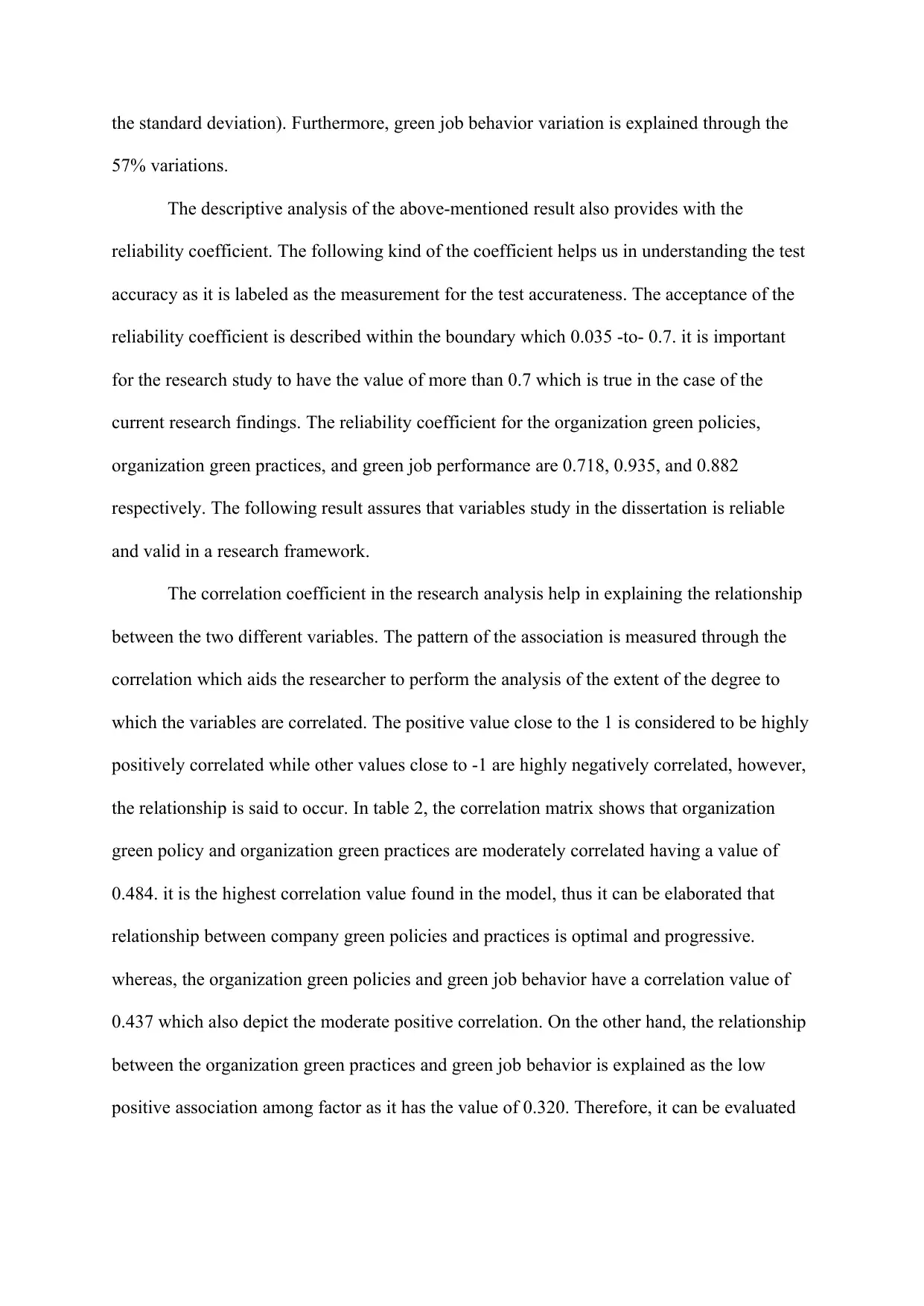
the standard deviation). Furthermore, green job behavior variation is explained through the
57% variations.
The descriptive analysis of the above-mentioned result also provides with the
reliability coefficient. The following kind of the coefficient helps us in understanding the test
accuracy as it is labeled as the measurement for the test accurateness. The acceptance of the
reliability coefficient is described within the boundary which 0.035 -to- 0.7. it is important
for the research study to have the value of more than 0.7 which is true in the case of the
current research findings. The reliability coefficient for the organization green policies,
organization green practices, and green job performance are 0.718, 0.935, and 0.882
respectively. The following result assures that variables study in the dissertation is reliable
and valid in a research framework.
The correlation coefficient in the research analysis help in explaining the relationship
between the two different variables. The pattern of the association is measured through the
correlation which aids the researcher to perform the analysis of the extent of the degree to
which the variables are correlated. The positive value close to the 1 is considered to be highly
positively correlated while other values close to -1 are highly negatively correlated, however,
the relationship is said to occur. In table 2, the correlation matrix shows that organization
green policy and organization green practices are moderately correlated having a value of
0.484. it is the highest correlation value found in the model, thus it can be elaborated that
relationship between company green policies and practices is optimal and progressive.
whereas, the organization green policies and green job behavior have a correlation value of
0.437 which also depict the moderate positive correlation. On the other hand, the relationship
between the organization green practices and green job behavior is explained as the low
positive association among factor as it has the value of 0.320. Therefore, it can be evaluated
57% variations.
The descriptive analysis of the above-mentioned result also provides with the
reliability coefficient. The following kind of the coefficient helps us in understanding the test
accuracy as it is labeled as the measurement for the test accurateness. The acceptance of the
reliability coefficient is described within the boundary which 0.035 -to- 0.7. it is important
for the research study to have the value of more than 0.7 which is true in the case of the
current research findings. The reliability coefficient for the organization green policies,
organization green practices, and green job performance are 0.718, 0.935, and 0.882
respectively. The following result assures that variables study in the dissertation is reliable
and valid in a research framework.
The correlation coefficient in the research analysis help in explaining the relationship
between the two different variables. The pattern of the association is measured through the
correlation which aids the researcher to perform the analysis of the extent of the degree to
which the variables are correlated. The positive value close to the 1 is considered to be highly
positively correlated while other values close to -1 are highly negatively correlated, however,
the relationship is said to occur. In table 2, the correlation matrix shows that organization
green policy and organization green practices are moderately correlated having a value of
0.484. it is the highest correlation value found in the model, thus it can be elaborated that
relationship between company green policies and practices is optimal and progressive.
whereas, the organization green policies and green job behavior have a correlation value of
0.437 which also depict the moderate positive correlation. On the other hand, the relationship
between the organization green practices and green job behavior is explained as the low
positive association among factor as it has the value of 0.320. Therefore, it can be evaluated
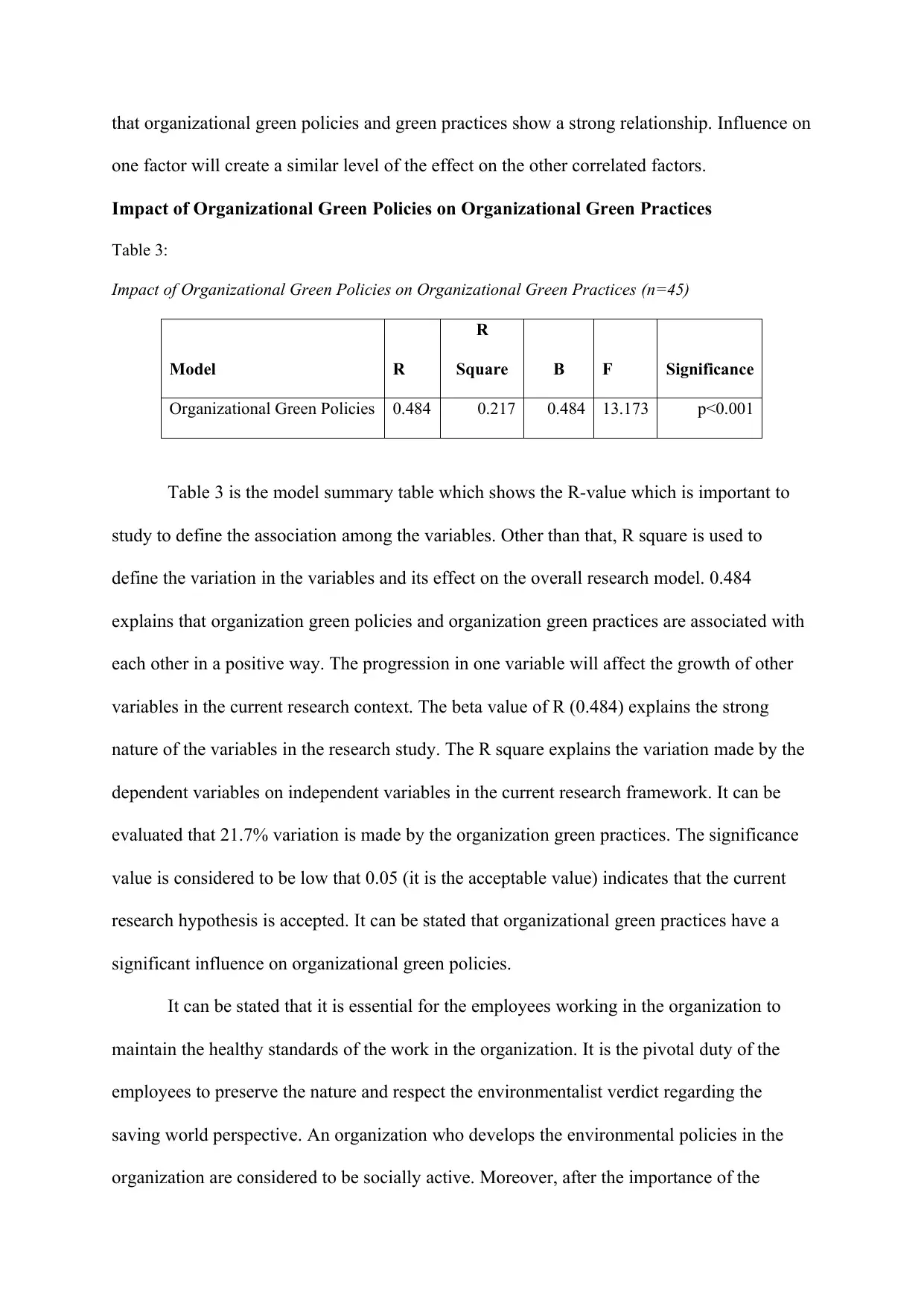
that organizational green policies and green practices show a strong relationship. Influence on
one factor will create a similar level of the effect on the other correlated factors.
Impact of Organizational Green Policies on Organizational Green Practices
Table 3:
Impact of Organizational Green Policies on Organizational Green Practices (n=45)
Model R
R
Square Β F Significance
Organizational Green Policies 0.484 0.217 0.484 13.173 p<0.001
Table 3 is the model summary table which shows the R-value which is important to
study to define the association among the variables. Other than that, R square is used to
define the variation in the variables and its effect on the overall research model. 0.484
explains that organization green policies and organization green practices are associated with
each other in a positive way. The progression in one variable will affect the growth of other
variables in the current research context. The beta value of R (0.484) explains the strong
nature of the variables in the research study. The R square explains the variation made by the
dependent variables on independent variables in the current research framework. It can be
evaluated that 21.7% variation is made by the organization green practices. The significance
value is considered to be low that 0.05 (it is the acceptable value) indicates that the current
research hypothesis is accepted. It can be stated that organizational green practices have a
significant influence on organizational green policies.
It can be stated that it is essential for the employees working in the organization to
maintain the healthy standards of the work in the organization. It is the pivotal duty of the
employees to preserve the nature and respect the environmentalist verdict regarding the
saving world perspective. An organization who develops the environmental policies in the
organization are considered to be socially active. Moreover, after the importance of the
one factor will create a similar level of the effect on the other correlated factors.
Impact of Organizational Green Policies on Organizational Green Practices
Table 3:
Impact of Organizational Green Policies on Organizational Green Practices (n=45)
Model R
R
Square Β F Significance
Organizational Green Policies 0.484 0.217 0.484 13.173 p<0.001
Table 3 is the model summary table which shows the R-value which is important to
study to define the association among the variables. Other than that, R square is used to
define the variation in the variables and its effect on the overall research model. 0.484
explains that organization green policies and organization green practices are associated with
each other in a positive way. The progression in one variable will affect the growth of other
variables in the current research context. The beta value of R (0.484) explains the strong
nature of the variables in the research study. The R square explains the variation made by the
dependent variables on independent variables in the current research framework. It can be
evaluated that 21.7% variation is made by the organization green practices. The significance
value is considered to be low that 0.05 (it is the acceptable value) indicates that the current
research hypothesis is accepted. It can be stated that organizational green practices have a
significant influence on organizational green policies.
It can be stated that it is essential for the employees working in the organization to
maintain the healthy standards of the work in the organization. It is the pivotal duty of the
employees to preserve the nature and respect the environmentalist verdict regarding the
saving world perspective. An organization who develops the environmental policies in the
organization are considered to be socially active. Moreover, after the importance of the
⊘ This is a preview!⊘
Do you want full access?
Subscribe today to unlock all pages.

Trusted by 1+ million students worldwide
1 out of 17
Your All-in-One AI-Powered Toolkit for Academic Success.
+13062052269
info@desklib.com
Available 24*7 on WhatsApp / Email
![[object Object]](/_next/static/media/star-bottom.7253800d.svg)
Unlock your academic potential
Copyright © 2020–2025 A2Z Services. All Rights Reserved. Developed and managed by ZUCOL.
